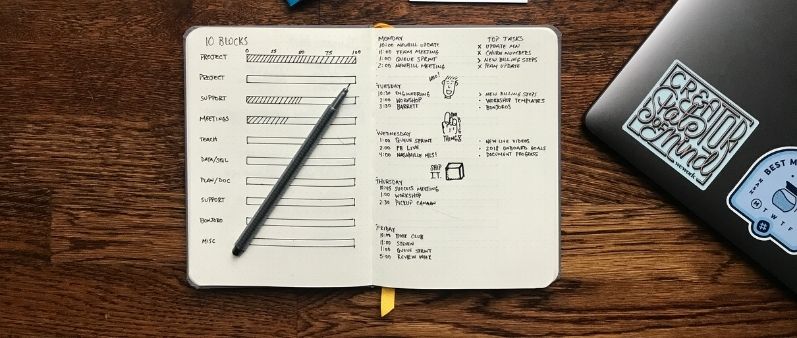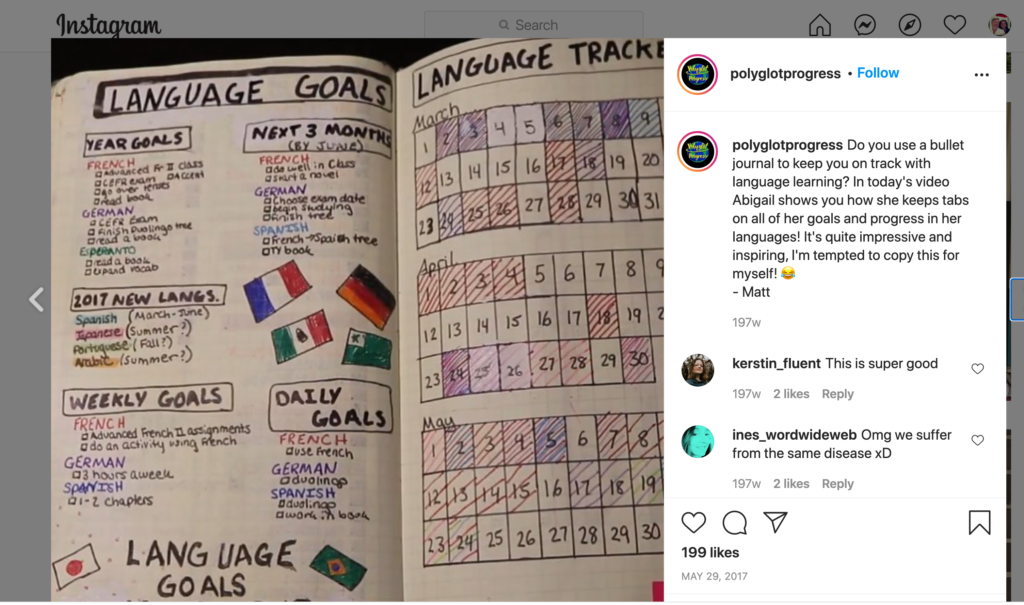
How to Make a Bullet Journal Your Secret Weapon for Language Learning
I started bullet journaling in November this past year and I’m obsessed. I very much drank the “bujo” kool-aid. I’ll probably be featured in a bullet journal cult recovery documentary three years from now.
All kidding aside, I really find it satisfying.
Not only does it help organize my day-to-day, but it has also become a kind of attractive log of my life. And I find the practice of taking time out to create my “spreads” and physically write everything down can be almost like a kind of meditation.
One of the other benefits I didn’t consider is that a bullet journal could be a really effective way to plan and keep track of your language learning. Over the past few months, I’ve spent more hours than I would like to admit in various YouTube holes watching polyglots planning their language learning with bullet journals.
That gave me a ton of ideas of how I could apply the bujo method to language learning, and I want to share some of what I’ve gleaned with you here.
So consider this to be your complete guide on using a bullet journal to learn a language.
Bullet Journals Make Organizing Your Life a Snap
For the complete beginner (i.e. me five months ago) a bullet journal is kind of a mix between an agenda, a journal, and a sketchbook. As Ryder Caroll, the originator of the bullet journal method says, it lets you “track the past, organize the present, and plan for the future.”
If you’re someone that likes to plan their life, you may be familiar with the difficulty of finding the perfect agenda. This one has great motivational quotes, but the calendar doesn’t quite work. You like that that one has space for your daily tasks and appointments, but you wish there was more space to write notes. That other one has a great way to keep track of your budget, but there’s no place to put your grades on your university assignments.
The bullet journal provides an answer to all that.
It’s blank except for little dots. The idea is that you can customize it so that it’s exactly what works for you.
Your Bullet Journal Basics
Bullet journals typically have at least four pieces:
- An index. This goes at the beginning of your journal. It pairs your later spreads with a page number so it’s easy to find what you’re looking for later. I actually don’t use this, but most people do.
- A future log. This helps you keep track of things you need to do in the future—in the next six months to a year.
- A monthly calendar. This helps you know what’s coming up in the next month.
- A daily task list. This is where you put all the stuff you need to do for the day.
You can also add a number of other additional spreads for things that matter to you: your vision for the year, a place to write a journal, a place to keep track of your expenses, etc. You can make it what you want.
This video helps explain bullet journaling basics really well.
Best Ways Use Your Bullet Journal for Language Learning
Now that you’ve got your bullet journal set up for your life, you can start to think about how it can be a useful tool to keep track of your language learning.
Here are some ideas for how you can use it.
1. Keep track of your language goals
Creating language goals is one of the most important parts of learning a language. They help you know what you want to accomplish so that you can stay focused and motivated to do the hard work of staying consistent with your learning.
Your bujo is the perfect place to keep track of your language goals or your New Year’s language resolutions.

2. Use It to Build Your Language Learning Program
To become fluent in a language, it helps to have a solid curriculum. That means having a program of what you’re going to learn first, what materials you will use, and so on.
Pimsleur can really help with that because the app takes a lot of the guesswork out of designing an effective language-learning program. But you still may want to track what your study plan is and the other activities you’ll do.
After you make your language study plan, put it in your bullet journal.
3. Use Your Bullet Journal to Create a Language Learning Routine
One way to stay consistent in learning a language is to make it part of your routine.
For instance, you might use your language learning app when having coffee in the morning. Or, you might listen to a podcast while you’re doing the dishes at night. Or, you might read a book before bed.
Making it a habit to study your language can be really effective. And you can efficiently track your habits in many ways in a bullet journal.
4. Use it to Measure and Track Your Progress
More than simply tracking when you’re studying your language or how often, you can also use it to measure your language progress.
Lindie Botes has a system for doing that that I really like. She fills in bars based on her self-assessed progress and where she’d like to be by the end of the year.
You could also keep track of your score on language tests or your self-rated level on the CEFR scale. However you do it, having a visual way to see how your language is improving can be really motivating.
5. Keep Track of Language Resources
You know reading is important for learning a language—why not keep a list of books you want to read in your bullet journal? Or use your bullet journal to keep track of the Netflix shows you’d like to watch in the language you’re learning. (We’ve got some ideas there if you’re learning French, Portuguese, Spanish, and Japanese.)
You could even list the podcasts you like, the video games you want to try out, or music you want to add to your playlist.
6. Plan Your Next Travel Destination
Hopefully, it won’t be too long before we can easily travel again—and your bujo is the perfect place to start your travel planning.
Use it to keep a travel bucket list or to brainstorm for your next adventure. And while you’re away, use it as a scrapbook to make notes of your cherished memories.
7. Keep a List of Recipes to Try
Cooking is a fantastic way to sharpen your language skills. Use your bullet journal to keep track of new recipes or old favorites.
8. Use Your Bullet Journal to Keep Track of New Vocabulary
Finally, your bullet journal can be used to house a vocabulary journal. Make notes of the new words and phrases you’re learning, and their definitions.
5 Bullet Journal Spreads for Language Learning
Bullet journals are powerful because they’re flexible: they can accommodate a ton of different styles.
But that can feel a bit intimidating, too. Where should you start?
Here are five journal spreads for language learning that I’ve found useful to inspire you. Of course, you should always feel free to design your own!
1. Language goals and habit tracker from Polyglot Progress
This language goal and tracker spread comes from Polyglot Progress. I love how Abigail has paired her goals with her habit tracker.
Abigail is learning multiple languages at once, so this spread lets her see her goals for each language and what days she has studied those languages (each color stands for a different language).
2. Word a Day vocabulary spread from the Boosted Journal

I love this spread for learning one new word a day from the Boosted Journal. It’s a fun way to build vocabulary over time.
3. Language tracker and resources spread
This beautiful language tracker from Imgur gives you space to track your activities (pages read, hours listened, and so on) as well as your favorite resources. It even gives you a spot to keep track of the grammar you still need to learn.
4. Minimal language study tracker
This simple monthly tracker brings some minimalism to your language study program. You just keep track of any language study you did that day. At the end of the month, you can self-assess your fluency as a percent of 100.
Over several months, you’ll be able to see your progress.
5. Visual vocabulary doodle page
Here’s another great option suggested by Written Chinese. It’s just a space to keep track of new vocabulary together with simple drawings of the word. Pairing the image with the character may be especially effective for learning Mandarin Chinese, but this tactic can be helpful in any language.
Try a Bullet Journal for Language Learning
Bullet journals are powerful organizers—and you can use them for language learning.
They’re great because they’re easy to start, and they’re fully customizable. The trick is in trial and error: finding a system and set of spreads that work for you.
If you’re looking to supercharge your language learning, pick up a bujo and give it a spin. You might just find that, like me, you become obsessed.
Discover How Speaking a New Language Changes Everything
Experience life-changing adventures. Create unforgettable memories. Easy listening, rewarding results in just 30 minutes a day!
Give us 30 minutes a day, and we’ll have you speaking your new language in no time. That’s all it takes for you to confidently inquire about prices, order dinner, ask for (or offer) directions – in your new language – with a near-native accent. Just listen, respond, and learn to converse in … Spanish while driving … Japanese while jogging … French while cooking. It’s really that portable and flexible. So what are you waiting for? When it comes to building actual conversational skills, nothing compares to the proven Pimsleur Method.
Enjoy a Free 7-Day Trial with unlimited access to all levels in the language of your choice! Afterward, pay as you go from $14.95 /month.
1 Comment for "How to Make a Bullet Journal Your Secret Weapon for Language Learning"